Atrial flutter EKG examples: Difference between revisions
m (Bot: Adding CME Category::Cardiology) |
|||
| (44 intermediate revisions by 2 users not shown) | |||
| Line 1: | Line 1: | ||
__NOTOC__ | __NOTOC__ | ||
{{CMG}} | {{CMG}}; '''Associate Editor-In-Chief:''' {{CZ}} | ||
'''For the main page on atrial flutter, click [[Atrial flutter|here]].''' | '''For the main page on atrial flutter, click [[Atrial flutter|here]].''' | ||
==EKG Examples== | |||
Shown below is an EKG depicting a 3:1 atrial flutter. | |||
Shown below is an | |||
[[File:AFLUTTER3.1.jpg|center|800px]] | [[File:AFLUTTER3.1.jpg|center|800px]] | ||
Copyleft image obtained courtesy of ECGpedia, http://en.ecgpedia.org/wiki/Main_Page | |||
---- | ---- | ||
Shown below is an | Shown below is an EKG depicting a 4:1 atrial flutter. | ||
[[File:AFLUTTER4.1.jpg|center|800px]] | [[File:AFLUTTER4.1.jpg|center|800px]] | ||
Copyleft image obtained courtesy of ECGpedia, http://en.ecgpedia.org/wiki/Main_Page | |||
---- | ---- | ||
Shown below is an | Shown below is an EKG depicting an atrial flutter with [[right bundle branch block]] demonstrated by Rsr' pattern in leads [[Electrocardiogram#Precordial|V1]], [[Electrocardiogram#Precordial|V2]], and [[Electrocardiogram#Precordial|V3]]. | ||
[[File:AFLUTTER.RBBB.jpg|center|800px]] | [[File:AFLUTTER.RBBB.jpg|center|800px]] | ||
Copyleft image obtained courtesy of ECGpedia, http://en.ecgpedia.org/wiki/Main_Page | |||
---- | ---- | ||
Shown below is an EKG from an 82 year old man with a history of lung disease and [[renal failure]]. At the time of this recording the patient was on [[iron]], [[lasix]], and [[bronchodilators]]. | Shown below is an EKG from an 82 year old man with a history of [[lung disease]] and [[renal failure]]. At the time of this recording the patient was on [[iron]], [[lasix]], and [[bronchodilators]]. The EKG shows a regular rhythm at a rate of 141/min. This patient had been in [[atrial fibrillation]] in the past and the rhythm here is probably [[atrial flutter]] with 2:1 block although no flutter waves are seen. The [[QRS]] duration is widened at 105 ms and the tall R waves in [[Electrocardiogram#Precordial|V5]] and S waves in [[Electrocardiogram#Precordial|V1]] and [[Electrocardiogram#Precordial|V2]] and the ST depression in the absence of [[digoxin]] suggest [[left ventricular hypertrophy]]. The [[QRS]] is too narrow for [[ventricular tachycardia]] and the brief R wave in [[Electrocardiogram#Precordial|V2]] with the clean down-stroke of the V2 S wave argue against a ventricular origin. The patient was placed on [[digoxin]] with a slowing of the ventricular rate and a rhythm that was clearly [[atrial fibrillation]] and with a [[QRS]] with the same morphology. | ||
The EKG shows a regular rhythm at a rate of 141/min. This patient had been in [[atrial fibrillation]] in the past and the rhythm here is probably [[atrial flutter]] with 2:1 block although no flutter waves are seen. The [[QRS]] duration is widened at 105 ms and the tall R waves in V5 and S waves in V1 and V2 and the ST depression in the absence of [[digoxin]] suggest [[left ventricular hypertrophy]]. The [[QRS]] is too narrow for [[ventricular tachycardia]] and the brief R wave in V2 with the clean down-stroke of the V2 S wave argue against a ventricular origin. The patient was placed on [[digoxin]] with a slowing of the ventricular rate and a rhythm that was clearly [[atrial fibrillation]] and with a [[QRS]] with the same morphology. | |||
[[Image:Atrial flutter in afib.jpg|center|800px]] | [[Image:Atrial flutter in afib.jpg|center|800px]] | ||
Copyleft image obtained courtesy of ECGpedia, http://en.ecgpedia.org/wiki/File:E338.jpg | |||
---- | |||
Shown below is an EKG depicting an atrial flutter with variable conduction. | |||
[[File:AFLUTTER.Variable.jpg|center|800px]] | |||
Copyleft image obtained courtesy of ECGpedia, http://en.ecgpedia.org/wiki/Main_Page | |||
---- | ---- | ||
Shown below is an EKG of a patient being treated with an external cardioverter/[[defibrillator]] for atrial flutter. The patient is under [[general anesthesia]] and two shocks were given, the first at 50 joules and the second at 100 joules. | |||
[[Image:Atrial Flutter.jpg|center|800px]] | [[Image:Atrial Flutter.jpg|center|800px]] | ||
Copyleft image obtained courtesy of ECGpedia, http://en.ecgpedia.org/wiki/File:E00031671.jpg | |||
---- | ---- | ||
Shown below is an EKG of a spontaneous termination of atrial flutter. The flutter waves can be seen deforming the QRS especially in leads [[Electrocardiogram#Limb|II]] and [[Electrocardiogram#Limb|III]]. | |||
[[File:Atrial flutter termination1.jpg|center|800px]] | [[File:Atrial flutter termination1.jpg|center|800px]] | ||
Copyleft image obtained courtesy of ECGpedia, http://en.ecgpedia.org/wiki/File:E207.jpg | |||
---- | ---- | ||
Shown below is an EKG depicting a spontaneous termination of atrial flutter. The termination occurs just at the first lead switch (e.g. lead [[Electrocardiogram#Limb|I]] to [[Electrocardiogram#Augmented lead|aVR]]). Note that the [[QRS]] does not change but is deformed by the large flutter waves that are running at a rate of about 300/min. There is [[low QRS voltage]]s (minus the flutter waves) in the [[precordial lead]]s (< 5 mm). | |||
[[File:Atrial flutter termination2.jpg|center|800px]] | [[File:Atrial flutter termination2.jpg|center|800px]] | ||
Copyleft image obtained courtesy of ECGpedia, http://en.ecgpedia.org/wiki/File:E192.jpg | |||
---- | ---- | ||
Shown below is an EKG of an atrial flutter with flutter waves seen best in the inferior leads and in leads [[Electrocardiogram#Precordial|V1]] to [[Electrocardiogram#Precordial|V3]]. The atrial rate is about 250/min. The QRS is wide (>120ms) and there is a tall R' wave in [[Electrocardiogram#Precordial|V1]] and a shallow S in [[Electrocardiogram#Precordial|V6]]. The axis of the QRS seems normal. The EKG shows a [[right bundle branch block]]. | |||
[[Image:Atrial flutter and RBBB.jpg|center|800px]] | [[Image:Atrial flutter and RBBB.jpg|center|800px]] | ||
Copyleft image obtained courtesy of ECGpedia, http://en.ecgpedia.org/wiki/File:E201.jpg | |||
---- | ---- | ||
Shown below is an | Shown below is an EKG depicting [[atrial tachycardia]] at about 240/min. (slow atrial flutter?) with 2:1 A/V block. The atrial activity is best seen in leads [[Electrocardiogram#Precordial|V1]], [[Electrocardiogram#Limb|III]] and [[Electrocardiogram#Augmented lead|aVF]]. | ||
[[Image:2to1AVBlock2.jpg|center|800px]] | [[Image:2to1AVBlock2.jpg|center|800px]] | ||
Copyleft image obtained courtesy of ECGpedia, http://en.ecgpedia.org/wiki/File:E0007571.jpg | |||
---- | |||
Shown below is an EKG depicting an atrial flutter in a patient with WPW syndrome. There is 1:1 conduction down a bypass tract. | |||
[[File:Atrial_Flutter_with_WPW.jpg|center|800px]] | |||
Copyleft image obtained courtesy of ECGpedia, http://en.ecgpedia.org/wiki/File:ECG_Aflutt_1to1.jpg | |||
---- | ---- | ||
==References== | ==References== | ||
{{Reflist|2}} | {{Reflist|2}} | ||
{{WH}} | |||
{{WS}} | |||
[[CME Category::Cardiology]] | |||
[[Category:Electrophysiology]] | [[Category:Electrophysiology]] | ||
| Line 66: | Line 69: | ||
[[Category:Cardiology]] | [[Category:Cardiology]] | ||
[[Category:Emergency medicine]] | [[Category:Emergency medicine]] | ||
[[Category:Up-To-Date cardiology]] | |||
[[Category:Up-To-Date]] | |||
Latest revision as of 01:27, 15 March 2016
Editor-In-Chief: C. Michael Gibson, M.S., M.D. [1]; Associate Editor-In-Chief: Cafer Zorkun, M.D., Ph.D. [2]
For the main page on atrial flutter, click here.
EKG Examples
Shown below is an EKG depicting a 3:1 atrial flutter.
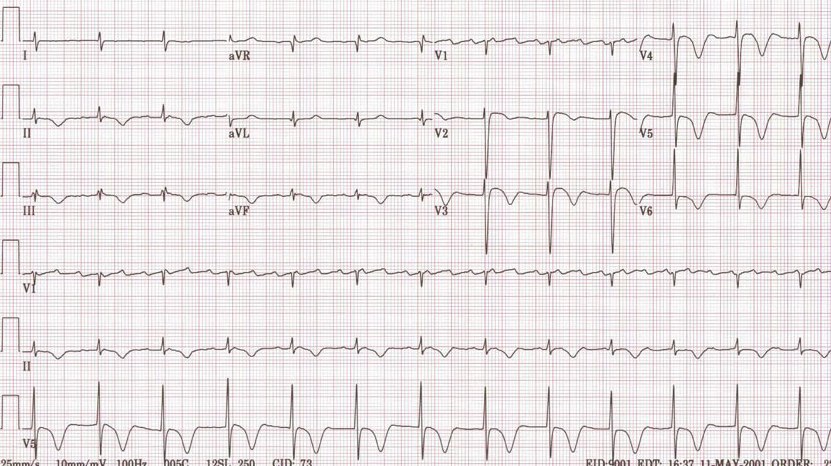
Copyleft image obtained courtesy of ECGpedia, http://en.ecgpedia.org/wiki/Main_Page
Shown below is an EKG depicting a 4:1 atrial flutter.
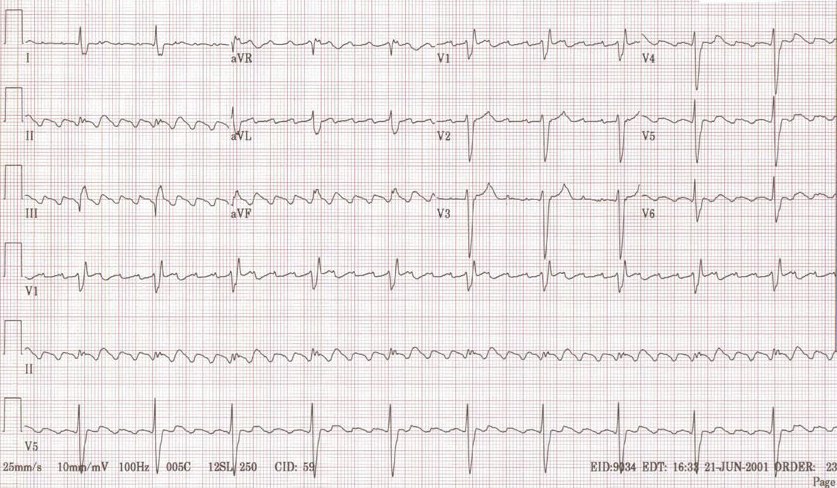
Copyleft image obtained courtesy of ECGpedia, http://en.ecgpedia.org/wiki/Main_Page
Shown below is an EKG depicting an atrial flutter with right bundle branch block demonstrated by Rsr' pattern in leads V1, V2, and V3.
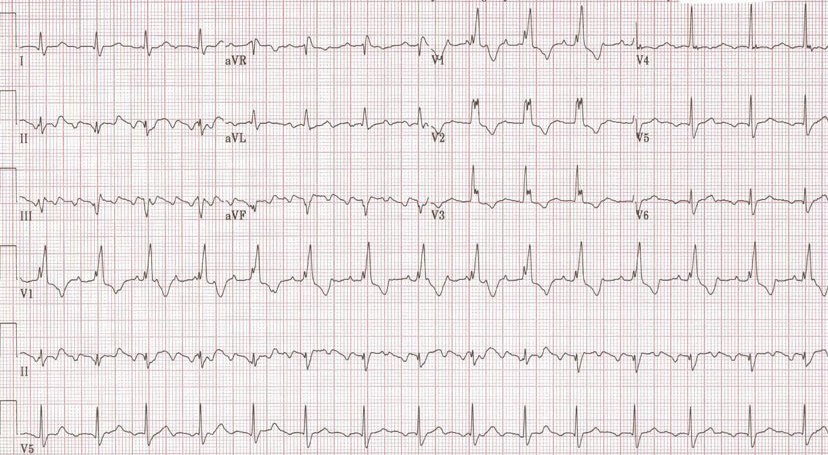
Copyleft image obtained courtesy of ECGpedia, http://en.ecgpedia.org/wiki/Main_Page
Shown below is an EKG from an 82 year old man with a history of lung disease and renal failure. At the time of this recording the patient was on iron, lasix, and bronchodilators. The EKG shows a regular rhythm at a rate of 141/min. This patient had been in atrial fibrillation in the past and the rhythm here is probably atrial flutter with 2:1 block although no flutter waves are seen. The QRS duration is widened at 105 ms and the tall R waves in V5 and S waves in V1 and V2 and the ST depression in the absence of digoxin suggest left ventricular hypertrophy. The QRS is too narrow for ventricular tachycardia and the brief R wave in V2 with the clean down-stroke of the V2 S wave argue against a ventricular origin. The patient was placed on digoxin with a slowing of the ventricular rate and a rhythm that was clearly atrial fibrillation and with a QRS with the same morphology.

Copyleft image obtained courtesy of ECGpedia, http://en.ecgpedia.org/wiki/File:E338.jpg
Shown below is an EKG depicting an atrial flutter with variable conduction.
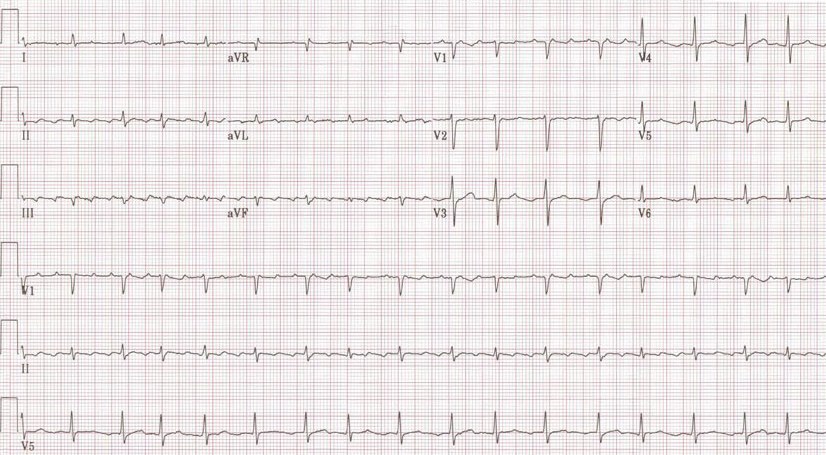
Copyleft image obtained courtesy of ECGpedia, http://en.ecgpedia.org/wiki/Main_Page
Shown below is an EKG of a patient being treated with an external cardioverter/defibrillator for atrial flutter. The patient is under general anesthesia and two shocks were given, the first at 50 joules and the second at 100 joules.

Copyleft image obtained courtesy of ECGpedia, http://en.ecgpedia.org/wiki/File:E00031671.jpg
Shown below is an EKG of a spontaneous termination of atrial flutter. The flutter waves can be seen deforming the QRS especially in leads II and III.

Copyleft image obtained courtesy of ECGpedia, http://en.ecgpedia.org/wiki/File:E207.jpg
Shown below is an EKG depicting a spontaneous termination of atrial flutter. The termination occurs just at the first lead switch (e.g. lead I to aVR). Note that the QRS does not change but is deformed by the large flutter waves that are running at a rate of about 300/min. There is low QRS voltages (minus the flutter waves) in the precordial leads (< 5 mm).

Copyleft image obtained courtesy of ECGpedia, http://en.ecgpedia.org/wiki/File:E192.jpg
Shown below is an EKG of an atrial flutter with flutter waves seen best in the inferior leads and in leads V1 to V3. The atrial rate is about 250/min. The QRS is wide (>120ms) and there is a tall R' wave in V1 and a shallow S in V6. The axis of the QRS seems normal. The EKG shows a right bundle branch block.
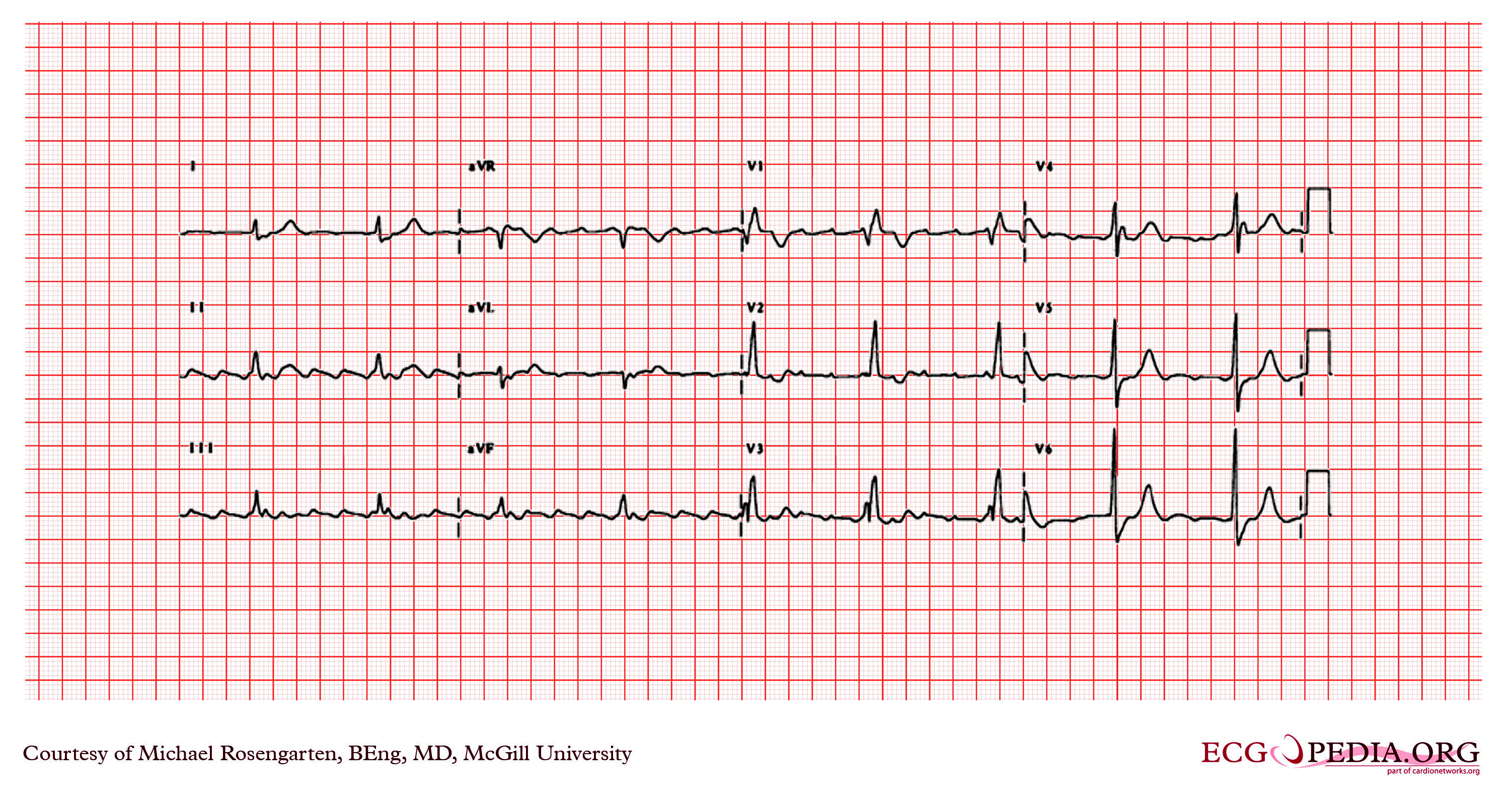
Copyleft image obtained courtesy of ECGpedia, http://en.ecgpedia.org/wiki/File:E201.jpg
Shown below is an EKG depicting atrial tachycardia at about 240/min. (slow atrial flutter?) with 2:1 A/V block. The atrial activity is best seen in leads V1, III and aVF.

Copyleft image obtained courtesy of ECGpedia, http://en.ecgpedia.org/wiki/File:E0007571.jpg
Shown below is an EKG depicting an atrial flutter in a patient with WPW syndrome. There is 1:1 conduction down a bypass tract.

Copyleft image obtained courtesy of ECGpedia, http://en.ecgpedia.org/wiki/File:ECG_Aflutt_1to1.jpg